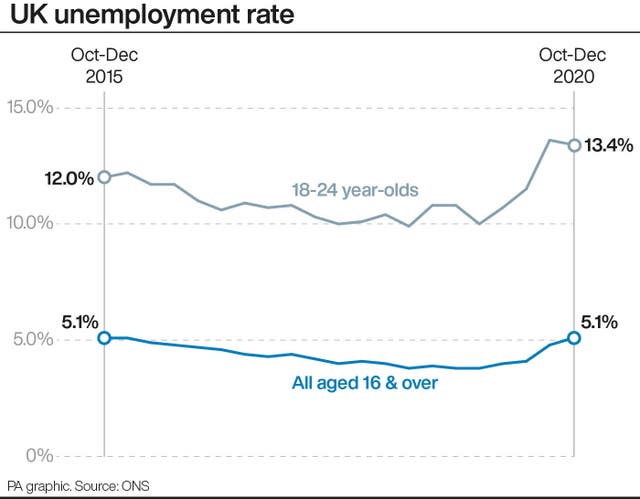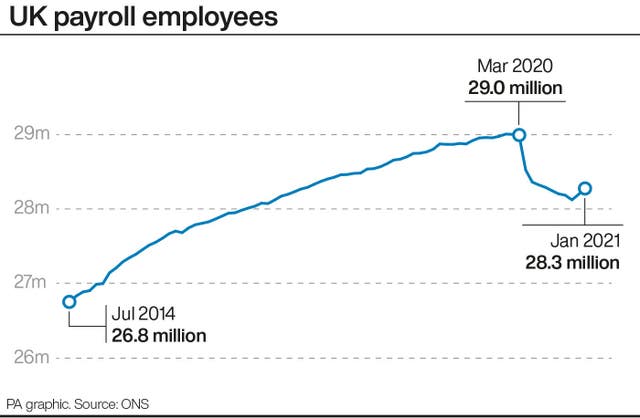Jobless rate hits 5.1% but data shows ‘early signs’ of stability
The Office for National Statistics said the number of payrolled workers rose by 83,000 between January and February.

Britain’s jobless rate has surged to its highest level for nearly five years with the pandemic hitting young workers hardest, but official figures revealed “early signs” of a stabilising jobs market.
The Office for National Statistics (ONS) said the rate of unemployment hit 5.1% between October and December – up from 5% in the previous quarter and its highest since early 2016.
It also revealed that there were 726,000 fewer workers on payrolls last month than before the start of the coronavirus crisis.
Nearly 60% of that drop – 425,000 – were for those aged under 25 in a sign of the toll taken by the crisis on young workers.
Overall, unemployment stood at 1.7 million between October and December, up 454,000 over the year, marking the biggest annual increase since the financial crisis.
But there was a glimmer of light in the figures, which also showed the number of payrolled workers rose by 83,000 between January and February in the second monthly increase in a row.
Chancellor Rishi Sunak pledged to set out his job support plans in next week’s Budget amid calls for more help from some of the sectors hammered by the crisis.
Mr Sunak said: “I know how incredibly tough the past year has been for everyone, and every job lost is a personal tragedy.”
“At the Budget next week I will set out the next stage of our Plan for Jobs, and the support we’ll provide through the remainder of the pandemic and our recovery,” he added.

The furlough scheme has been helping cushion some of the blow of the pandemic, though there are fears of a spike in unemployment when it comes to an end.
Jonathan Athow, deputy national statistician at the ONS, said: “The latest monthly tax figures show tentative early signs of the labour market stabilising, with a small increase in the numbers of employees paid through payroll over the last couple of months.”
He said the proportion of people neither working nor looking for work had also stabilised after surging at the start of the pandemic, with “many people who lost their jobs early on having now started looking for work”.
Figures showed there was also a welcome rise in vacancies between November to January, up 64,000 on the previous quarter.
The claimant count – another measure that includes people working with low income and hours as well as people who are not working – also decreased slightly in January, down 0.8% month-on-month to 2.6 million.

But this is still double the level seen in March 2020.
Total wages rose by 4.7% annually over the quarter to December, thanks to end of year bonuses, but the ONS stressed that, with a high proportion of jobs axed being lower-paid roles, the underlying increase is likely to be around 3%.
The Bank of England is forecasting the jobless rate to surge to almost 8% by the middle of 2021, however Mr Sunak is expected to announce an extension of job support in the March 3 Budget.
Economist James Smith, at ING, said: “The latest UK jobs data provides further evidence that the jobs market stabilised in the final weeks of 2020, following a turbulent autumn.”
But he cautioned: “We suspect that the unemployment rate will rise to around 6-6.5% through the middle of the year, and potentially higher if wage support is removed fairly abruptly in the second quarter.”





